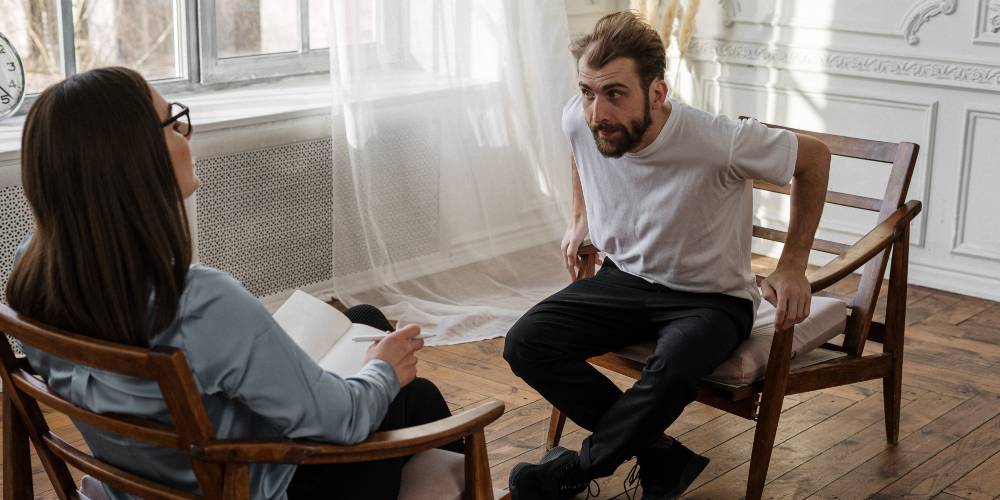Ever since Freud popularized psychoanalysis at the tail end of the 19th century, folks have turned to psychotherapy for support with everything from understanding their unconscious mind to finding ways to cope with unmanageable emotions or shifting difficult thoughts and behaviors.
With traditional psychoanalysis, patients might see the same therapist for a year or more, exploring, for example, how their early childhood may have influenced their development, assumptions about the world, and how they arrived at their unique personality.
However, in recent times, shorter-term, goal-oriented therapy has grown in massive popularity, in particular cognitive behavioral therapy (CBT).
approach was first developed back in the 1960s by the late American psychiatrist Dr. Aaron Beck, when he noticed his patients repeatedly seemed to express similar negative types of ‘automatic thoughts’ (for example, ‘I am inadequate’ or ‘My future looks hopeless’).
CBT involves challenging these everyday distorted, negative – often repetitive – thoughts that can severely impact happiness and lead to destructive behaviors. In effect, it’s a way to ‘rewire your mind.’
Rather than years on the couch, one of CBT’s great appeals is it doesn’t require huge time commitments. Often, a few sessions are enough to teach practical, common-sense techniques that support positive change.
While CBT is commonly used to ease anxiety and depression, it’s also shown to help clients manage physical pain triggered by illness and chronic conditions, and other mental health issues.
Due to its clear, no-nonsense approach that shows results, CBT has become the leading type of therapy offered in medical settings in certain countries. In the UK, for example, the government adopted CBT as standard in 2007. And you’d be hard-pressed NOT to find at least some CBT in a clinic or hospital in the US.
Read on to explore the strengths and weaknesses of CBT to determine if it is right for you.
What is Cognitive Behavioral Therapy?
Cognitive behavioral therapy (CBT) is a popular form of talking therapy that focuses on helping you manage your problems by changing the way you think.
A therapist can help you spot patterns, and look at strategies to stop you becoming trapped in repetitive cycles of negative thoughts, feelings and behaviors (something nearly all of us experience at one time or another).
Unlike some types of talking therapy or counselling, CBT tends to focus on problems in the ‘here and now’, rather than things that happened to you in the past (though you might well still talk about some of these issues during your sessions).
CBT’s goal is to:
- find practical ways for you to manage your mood
- physical sensations
- feelings on a daily basis
- and challenge unhelpful beliefs about yourself, the world and other people.
Typically, a course of CBT lasts from 5 to 20 sessions, with each session lasting from 30 to 60 minutes (50 minutes is often standard).
Your therapist will give you exercises to try between sessions to help you shift your thinking patterns and find alternative ways of viewing and interpreting things.
How is CBT used for mental health treatment?
CBT is commonly used to help manage symptoms of anxiety and depression. Studies have suggested it’s effective for treating depression alongside taking antidepressants and may help with a range of anxiety disorders.
Other mental health issues that CBT might help with include:
- obsessive-compulsive disorder (OCD)
- post-traumatic stress disorder (PTSD)
- phobias (including agoraphobia and social phobia)
- panic disorders.
It can be used to support conditions including borderline personality disorder, bipolar disorder and eating disorders. It might also help with problems like low self-esteem or anger issues.
CBT helps you make sense of your problems by breaking them down into smaller chunks, so you understand how they’re connected and you’re affected. For example, you might look at a specific situation, and identify or ‘catch’ the thoughts, emotions, physical sensations and behaviors that result from triggers.
p>catastrophizing’ – where we automatically, and irrationally, assume the worst about ourselves, what someone else thinks of us or a situation (often using language that reflects this), imagining the worst possible future outcomes. ( eg ‘I’m useless, and I’ll never get a job again’, or ‘I’ve had a fight with my partner; now they hate me and my day is ruined.’).
A technique often used in CBT is ‘reframing’ where you challenge your automatic thoughts and replace them with more positive interpretations. In a typical exercise, you might be asked to write down the thoughts and feelings you experienced in a certain situation. (‘X ignored me in the office – they don’t like me.’).
You might consider whether these thoughts are rational or if there are alternative ways to view the situation (Eg ‘Perhaps they’re wrapped up in work worries.’).
For a patient with a phobia, CBT treatment might involve gently exposing yourself to the source of your fear, with your therapist’s guidance and support.
‘Activity scheduling’ is another CBT technique shown in studies to be helpful for managing anxiety and depression. Here patients identify the things that give them joy, then document them, to help them better manage their mood.
Your therapist might introduce you to exercises to help you manage anxiety involving, for example, deep breathing, mindful visualizations or muscle relaxation. (There is a strand of CBT known as MBCT, or mindfulness-based cognitive behavioral therapy, which specifically combines CBT with elements of mindfulness, including meditation.)
Ready to try a new way to manage your health?
How is CBT used for physical health treatment?
You might be surprised to learn that CBT isn’t just effective for mental health issues.
There’s evidence it can assist with certain physical problems including:
- Sleep issues
- irritable bowel syndrome (IBS)
- hot flashes (in
- menopausal women)
- chronic fatigue
- fibromyalgia
- and more
This isn’t to say that these conditions are ‘all in the mind’. CBT won’t cure the physical symptoms of these issues, but it might help people better cope with them, so they don’t disrupt daily life as much.
Strengths and Weaknesses of CBT
As with any type of therapy, there are both pros and cons for choosing CBT. It all comes down to choosing the right fit for your particular needs. Let’s take a look at pros and cons and let you decide what you need. Or you can always give us a ring at +1 (857) 990-6111 or register for us to call to assist you.
Reasons CBT may benefit you
CBT is established as an effective, efficient way to help people deal with issues including low mood and anxiety. In studies, it’s shown to be as effective as antidepressants for some types of depression, and believed to be the most effective psychological treatment for moderate and severe depression.
Many patients like the fact that CBT offers practical strategies for a particular problem – (e.g., managing panic attacks). This can offer you a sense of control and give an ‘emotional toolbox’ of techniques that can be drawn on in the future, after your sessions end.
Top reasons to seek CBT may include:
- It is short-term and goal -oriented. Some people greatly appreciate that CBT can fit easier into a busy life due to the brevity of the modality – a possible strength, when many of us are juggling jobs, families and other commitments.
- You can focus on the present. Not everybody wants to talk at length about their past or will find it useful (and some might not feel ready to). CBT’s focus on present issues might feel more helpful every day.
- CBT is highly structured. It can be accessed via different formats, including worksheets, books and online courses – making it easy to build into your schedule and think about with actionable tasks.
Reasons you may see CBT as a weakness
- CBT involves a level of commitment on the part of the patient, including homework. If you don’t like ‘homework’, it may not for you as you will need to actively spend time finding ways to change your thinking patterns and ‘retraining your mind’ for it to be effective. If you’re suffering from very low mood, you might lack motivation and find it hard to engage with any exercises your therapist sets you.
- CBT doesn’t specifically aim to help you understand WHY you behave in or feel a certain way due to, for example, your childhood experiences, upbringing or previous relationships. (Though you might find that you better understand aspects about yourself as a result of having CBT.) Some patients prefer an approach where they can explore their past and the causes of their distress in more depth.
- CBT puts the onus on the individual to change their thoughts or behaviors. It won’t explore any issues in your family or support networks, or wider societal issues, which can have a major impact on an individual’s wellbeing and mental health.
- With CBT, your therapist will usually drive the sessions, making suggestions or offering advice, and adopting the role of ‘expert’. Some patients may prefer a more client-centered approach, where the patient leads the conversation in their own time.
- CBT’s structured nature means it might not be suitable for patients who have more complicated mental health needs or learning disabilities. That said, many clinics and therapists incorporate CBT into their eclectic treatment style and have found success even with people experiencing serious and persistent mental illnesses.
How XRHealth Uses CBT to Treat Patients
XRHealth takes CBT to the web 3.0 or metaverse, aka the virtual world, by combining it with telehealth services and virtual reality applications. While it might seem like you’re just playing games, it’s anything but ‘just a game.’
Our FDA registered VR apps are designed to help you ‘rewire your brain’ as you replace unhealthy thoughts and behaviors with healthier ones. In addition, a licensed XRHealth therapist meets with you online weekly (or as otherwise scheduled) to set goals, support you on your recovery journey, and monitor your progress.
To get started now, complete our easy online quiz now.
CBT Takeaway
- CBT is clinically proven to be a highly efficient way to help manage anxiety and depression. It’s wide-ranging in its positive outcomes for many mental health issues. Under the right conditions, changing how your view the world can be life-changing day-to-day.
- It might also help with physical conditions such as, for example, IBS, extreme fatigue, or the pain of fibromyalgia.
- It’s an appealing approach if you’re someone who’s goal-oriented and seeking a practical, accessible way to manage difficult feelings, mental or physical.
- However, CBT isn’t a magic pill that will cure all your troubles. It involves work and commitment on the part of the client and if you’re in a very low place or have more challenging needs, doing written exercises, for example, might feel daunting or plain impossible.
- The strong focus on the present isn’t for everyone. Some will prefer a longer-term approach that offers space to delve deeper into their personal history and better understand themselves.
- Bear in mind, even if it’s not for you right now, it’s something you could turn to in the future – so learning some simple techniques for challenging negative thinking patterns might still be very valuable.
- Given that CBT is a practical, short-term approach many find relatively easy to fit into a busy lifestyle, it’s definitely worth trying.














